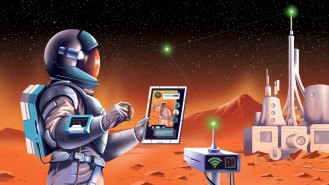‘Nuts and Bolts’ showcases the 7 building blocks of modern engineering
The book updates the classic list of simple machines

Computer hard drives use magnets to store information. Magnets, a new book argues, is one of seven elements that form the basis of engineering today.
By Anna Demming
Nuts and Bolts
Roma Agrawal
W.W. Norton & Co., $29.99
What do you get when you pose a challenge, weave in a cast of characters driven by hunger, frustration, curiosity, compassion or maybe even a little spite, and throw in a few twists and turns? A book about engineering.
In Nuts and Bolts, structural engineer Roma Agrawal offers an updated twist on the list of six basic machines — the lever, wheel and axle, pulley, inclined plane, wedge and screw — that Renaissance scientists and engineers identified as fundamental to that era’s technology. Seven elements, Agrawal argues, “form the basis of the modern world”: the nail, wheel, spring, magnet, lens, string and pump (SN: 4/26/22). If the objects included in — or excluded from — the list are hotly debated among professional engineers and laypeople alike, Agrawal may not mind. A key message of the book is that engineering is for people of all sorts.
Each element gets its own chapter. Precise yet simple descriptions of each object’s operating principles, plus helpful hand-drawn diagrams, make the book accessible to the uninitiated. Agrawal’s zeal for engineering jumps off the page through her vivid descriptions. This is someone who describes the ticking of mechanical watches as “soothing” — a soul nourished by invention and craftsmanship.
After reviewing how each invention bears, balances and leverages the physical forces and fields acting on it, Agrawal places the seven elements within the various technologies they facilitate, from planes and bridges to instruments, guns and television. With these tales of invention come familiar characters, like Alexander Graham Bell, but also pioneers largely forgotten by posterity, including “the often hidden or unacknowledged contribution of minoritized people in engineering.”

There are the Mongolian archers who finessed the spring of their bows by combining materials with different benefits, and the 11th century Arab polymath Ibn al-Haytham who established many of the optics principles essential for designing lenses (SN: 2/24/15). A 19th century American housewife makes an appearance — her frustration with staff breaking her fancy dishes drove her to invent an automatic dishwasher based on cogs (which are derived from wheels) — as does a spiteful undertaker. In 1892, he patented a mechanical “girl-less, cuss-less, out-of-order-less, wait-less” (his words not Agrawal’s) telephone exchange using magnets to take the job of telephone operators. These workers, typically women, had connected the wires for the caller with those of the person they were calling, and it turns out one of them had been redirecting the undertaker’s potential clients to her husband.
The key character bringing all these stories together is Agrawal herself, whether she’s recounting her efforts at a blacksmith’s forge or on a potter’s wheel (yes, according to Agrawal, the wheel has been reinvented many, many times) or describing the IVF she underwent and the microscope lenses the embryologist used when joining her daughter’s first two cells together. We see Agrawal the professional engineer, as well as Agrawal the inquisitive child, teenage classical Indian dancer, student and mom. The net result is more touching than you might expect from an engineering book.
Agrawal ends with the pump. To demonstrate how this mechanical tool moves fluids, Agrawal focuses on breast pumps. A car engine might seem a more obvious exemplar, but the story of the breast pump illustrates the importance of user-oriented engineering. “I felt like a farm animal amid the various contraptions attached to my breast,” Agrawal writes of her own experience with traditional breast pumps, apparently “no coincidence, as the inspiration for an early breast pump came from milking cows.”
These clunky, slow, often manually operated pumps can be awkward to use anywhere but at home or in a bathroom, unlike the recently developed Elvie breast pump, which fits in a woman’s bra and pumps automatically and discreetly while she gets on with her life. It’s refreshing to hear someone describe so frankly the exhaustion and the pain many women experience while breastfeeding.
The Elvie breast pump shows how crucial it is for engineers to have a thorough understanding of the needs of the people who will use the device and why engineering needs people from all sorts of backgrounds.
Buy Nuts and Bolts from Bookshop.org. Science News is a Bookshop.org affiliate and will earn a commission on purchases made from links in this article.








